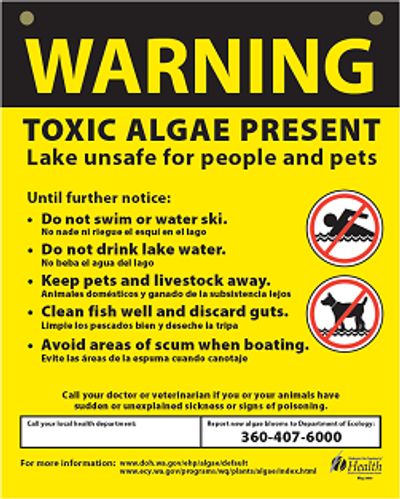The water quality of Offut Lake is considered Fair. It has high nutrient levels and severe fall and spring algae blooms. Rooted aquatic plants in some near-shore areas interfere with some lake uses by shoreline property owners and boaters. The average of three TSI values categorized Offut Lake as eutrophic in 2018 and mesotrophic in 2019. The surface Total Phosphorus (TP) concentration exceeded the action level for mesotrophic lakes both years. Based on the surface TP concentration alone, Offut Lake would be classified as eutrophic and both 2018 and 2019. There were multiple reports of algae blooms with surface scum in 2018 but none of the samples exceeded the Washington Advisory level for algae toxins. The lake was also tested in 2020 and did not exceed the advisory levels for toxins.
Nitrogen to Phosphorus Ratios
Inorganic nutrients, particularly the elements phosphorus and nitrogen are vital or algae nutrition and cellular constituents. Over enrichment of surface waters leads to excessive production of autotrophs, especially algae and cyanobacteria.
In both 2018 and 2019 concentration of TP at the surface peaked when the water column began to mix in September. Thermal stratification reduced internal loading to surface waters from June to August. Changes in the phytoplankton community and external sources likely affect nutrient levels during stratification.

From 2018 and 2019 Offut Lake Water Quality Report:
Eutrophication: The process by which an entire body of water, or parts of it, becomes progressively enriched with minerals and nutrients. The most common nutrients causing eutrophication are nitrogen and phosphorus. The main source of nitrogen pollutants is run-off from agricultural land, whereas most phosphorus pollution comes from households and industry, including phosphorus-based detergents.
Mesotrophic: “Meso” means middle or mid; therefore, mesotrophic means a medium amount of nutrients (Phosphorus and Nitrogen). Lakes with an intermediate level of productivity are called mesotrophic lakes. These lakes have medium-level nutrients and are usually clear water with submerged aquatic plants.
Eutrophication in aquatic systems causes algae and cyanobacteria to grow rapidly and form blooms. The decomposition of dead algae and cyanobacterial cells by bacteria depletes the supply of dissolved oxygen in the water, potentially suffocating fish and other aquatic organisms.
Nitrogen is limiting to lake productivity, but supplies are more readily augmented by inputs from external sources. The State of Washington does not have established action or cleanup levels for surface total nitrogen.
Compared to the rich supply of other elements required to nutrition or structure, phosphorus is the least abundant and most commonly limits biological productivity. Lakes in this region experience undesirable algae growth when the annual average surface phosphorus level reaches .030 mg/L.
2018 TP surface Mean .028 mg/L 2018 TP Bottom means .195 mg/L
2018 TP Surface Median .014 mg/L 2018 TP Bottom Median .123 mg/L
2018 TP Surface Std Dev. 022 mg/L 2018 TP Bottom Std Dev .181 mg/L